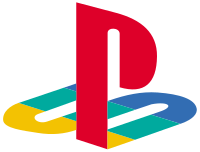PlayStation (console)
The PlayStation[a] (abbreviated as PS, commonly known as the PS1 or its codename PSX) is a home video game console developed and marketed by Sony Computer Entertainment. It was released on 3 December 1994 in Japan, 9 September 1995 in North America, 29 September 1995 in Europe, and 15 November 1995 in Australia. As a fifth-generation console, the PlayStation primarily contended with the Nintendo 64 and the Sega Saturn.
PlayStation



Top: The original model (1994) with the
DualShock controller (1997)
Bottom: The smaller, redesigned PS One (2000)
Also known as
PSPS1PSonePS One (redesign)PSX (codename)
Developer
Sony Computer Entertainment
Manufacturer
Sony Electronics
Product family
PlayStation
Type
Home video game console
Generation
Fifth generation
Release date
PlayStation
JP: 3 December 1994[2]
NA: 9 September 1995[1]
EU: 29 September 1995[3]
AU: 15 November 1995[4]
PS One
JP: 7 July 2000
NA: 19 September 2000
EU: 29 September 2000
Lifespan
1994–2006 (12 years)
Introductory price
¥39,800, US$299,[5] £299,[6] F1,490, DM599[3]
Discontinued
WW: 23 March 2006[7][8]
Units sold
102.49 million[7]
Media
CD-ROM
CPU
R3000 @ 33.8688 MHz
Memory
2 MB RAM, 1 MB VRAM
Storage
Memory card
Sound
16-bit, 24 channel ADPCM
Controller input
PlayStation Controller, PlayStation Analog Joystick, Dual Analog Controller, DualShock
Connectivity
PlayStation Link Cable
Best-selling game
Gran Turismo, 10.85 million shipped[9][10]
Successor
PlayStation 2
Sony began developing the PlayStation after a failed venture with Nintendo to create a CD-ROM peripheral for the Super Nintendo Entertainment System in the early 1990s. The console was primarily designed by Ken Kutaragi and Sony Computer Entertainment in Japan, while additional development was outsourced in the United Kingdom. An emphasis on 3D polygon graphics was placed at the forefront of the console's design. PlayStation game production was designed to be streamlined and inclusive, enticing the support of many third-party developers.
The console proved popular for its extensive game library, popular franchises, low retail price, and aggressive youth marketing which advertised it as the preferable console for adolescents and adults. Premier PlayStation franchises included Gran Turismo, Crash Bandicoot, Tomb Raider, and Final Fantasy, all of which spawned numerous sequels. PlayStation games continued to sell until Sony ceased production of the PlayStation and its games on 23 March 2006—over eleven years after it had been released, and less than a year before the debut of the PlayStation 3.[8] A total of 7,918 PlayStation games were released, with cumulative sales of 962 million units.
The PlayStation signalled Sony's rise to power in the video game industry. It received acclaim and sold strongly; in less than a decade, it became the first computer entertainment platform to ship over 100 million units.[11] Its use of compact discs heralded the game industry's transition from cartridges. The PlayStation's success led to a line of successors, beginning with the PlayStation 2 in 2000. In the same year, Sony released a smaller and cheaper model, the PS One.
Nice topics
EXCILLENT
EXCILLENT
আমরা তো বুড়ো হয়ে গেছি, আমাদের কি আর প্লে ষ্টেশন নিয়ে খেলার বয়স আছে। 😀😀😀 , বাই দ্যা ওয়ে, ইনফরমেশনগুলো ভালো লাগলো। ধন্যবাদ।